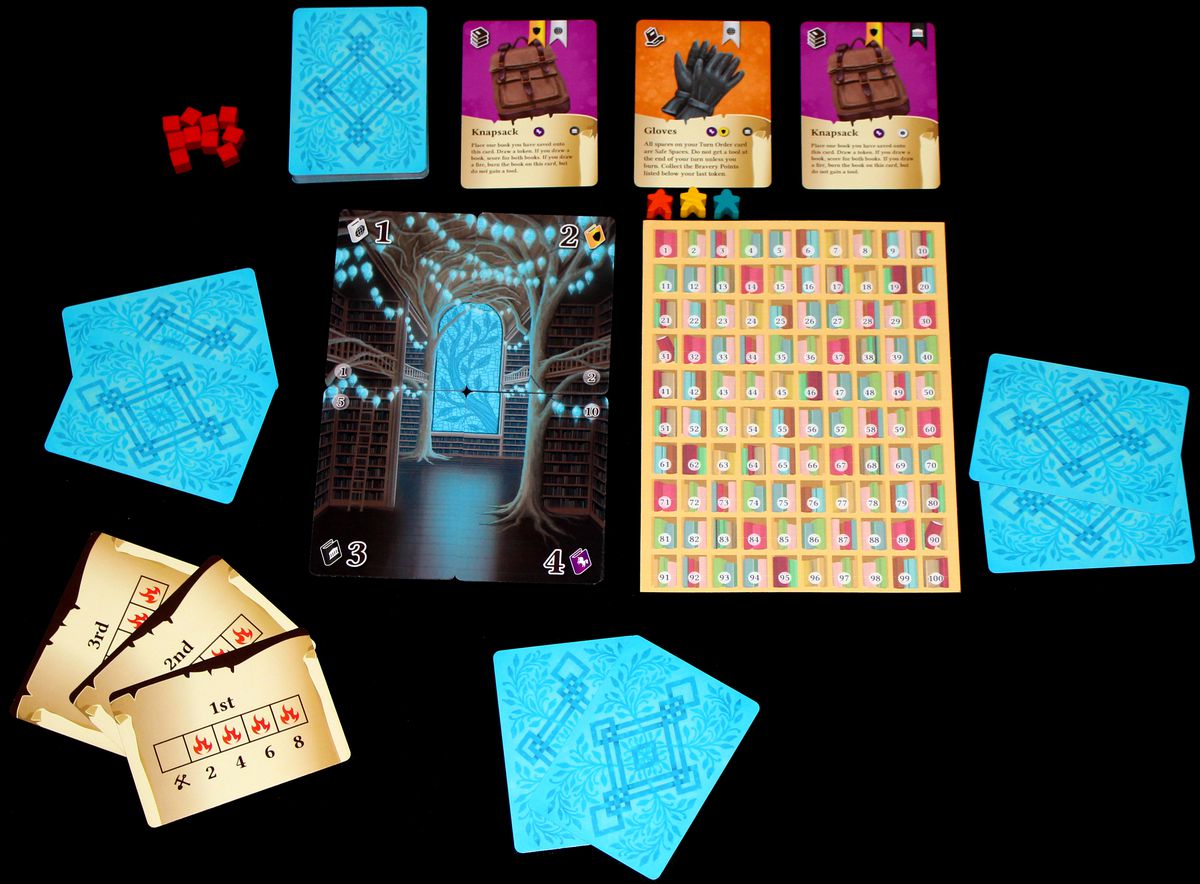Save Books While Avoiding the Fire in the Library

The library is ablaze and books of magic and myth are threatened by the raging fire. Save all the literature you can in this press-your-luck game.
Gameplay
Fire in the Library is a 1-6 player game in which each player is tasked with saving as many books as possible from the inferno engulfing the bookish institution. Play begins by setting up the 26 library cards into four piles in a 2-by-2 grid, separated by the colorful book icon on each. Each card should be stacked in descending order. Next, shuffle the tool cards (taking out the necessary tool cards that correspond to the number of players) and deal two face-down to each player. Set out player order cards equal to the number of players in a game (1-3 player games have different rules for using player order cards). Finally, place all colored cubes (matching the color of the books on each library card stack) as well as 7 red fire cubes into the bag.
In the first round, player order cards will be turned face-down, shuffled, and dealt. The player with the first player order card will draw from the library bag first. Each player order card will offer different gameplay choices, with higher player orders (first and second players) having more risky spaces than players with lower player order cards (fifth and sixth players). Risky spaces are denoted by the fire symbol. When drawing out of the bag, players will choose one cube at a time and place it in the left-most empty space on their player order card. If they draw one red cube but it occupies a space that is not a risky space, any books they have are currently safe. However, if a player draws a red cube into a risky space or draws a second red cube, any books they have saved are burnt up, meaning the player will earn no points. This will cause the fire to spread to the corresponding sections of the library cards, meaning any cubes that match the color of the books will cause one card to be removed from that section of the library. If the next card in the pile shows a fire symbol, a fire cube is added to the bag.
Tool cards can help players mitigate some of the risk during their turn as well as provide opportunities for end of the game scoring. Much like the rest of the game, some tool cards will offer another layer of chance without causing any dubious secondary penalties for choosing to use them.
Player order cards will also have symbols for tools as well as bravery points. If a player saves books and doesn’t draw any fire cubes, or chooses to end their turn after saving books, they may earn a new tool card or bravery points as denoted under each space on the player order card. Risky spaces typically have bravery points under them, meaning that not only will a player score the total of the books they’ve saved, but will earn the requisite bravery points from the last successful space they filled.
If a player decides to end their turn and hasn’t caused their books to burn, they will score their books by looking at the corresponding library pile for each colored cube they have collected. As the fire spreads to certain sections, the value of each colored book will increase.
After all players have taken a turn, the library card with the smallest number will be removed (a fire cube will be added to the bag if a fire symbol is uncovered) and the player with the lowest score will then get to pick which player order card they would like, then the player with the next lowest score, and so on. Play continues until the first 10-point library card is revealed, which immediately ends the game. Players will score any end-of-game tool cards, add it to their totals on the scoring track, and the player with the most points wins the game.

Photo by Erik Yurko, licensed under CC BY-NC-SA 3.0.
Review
Fire in the Library does a fantastic job balancing its many press-your-luck elements to ensure that any game can be a wild runaway or a tight-knit scoring affair and yet, either is a fun and quick experience that will make players exclaim “Let’s play it again!” While it’s a gambling simulation in many ways, the thrill of taking a chance with the strategies the player order, tool, and library cards offer is undeniably infectious.
The theme is where some of the game’s shine really comes through. While the mythos is not deep, the idea that players are racing to save as much of human history as possible from a library on the edge of collapse provides a safe theme to explore inherent instincts in all of us to push a little further, try a little harder, and take bigger chances than normal.
The game isn’t without its slight faults. The rulebook can be a bit difficult read and over-complicates what is otherwise a straight-forward affair. Thankfully, it offers an example turn that helps solidify some of its finer points. And to be fair, explaining those finer points is necessary so players can have a fun experience — again, think of Fire in the Library as a casino game and knowing the best times to press one’s luck or when to back off and play it safe is key to success.
With fun, fantastical art from Beth Sobel and Katie Khau, Fire in the Library will also be easy on the eyes while providing a brief glimpse into a magical world. Designers Tony Miller and John Prather have captured a bit of fantasy amidst a gambling zeitgeist that is undeniably cute and safely addictive.
Pros: Fun press your luck mechanics that can layer to make rewarding decisions, Vibrant art that draws players into the theme
Cons: Disorderly rulebook




